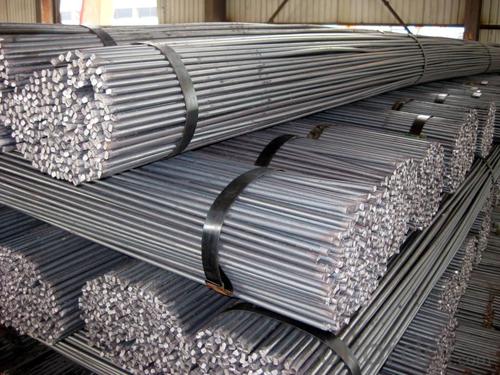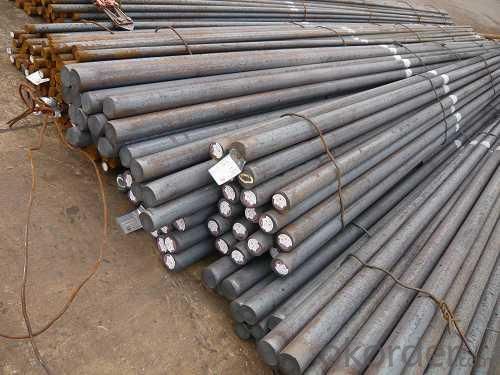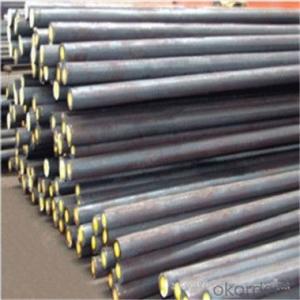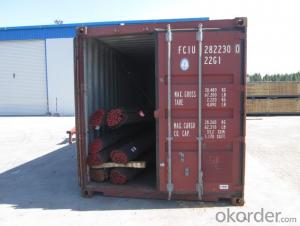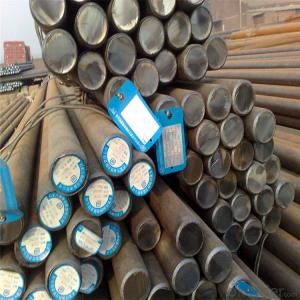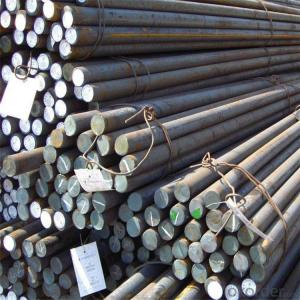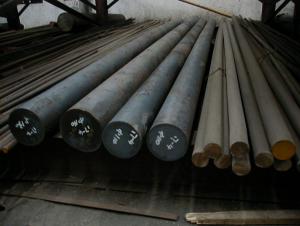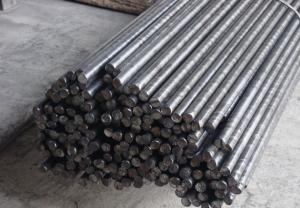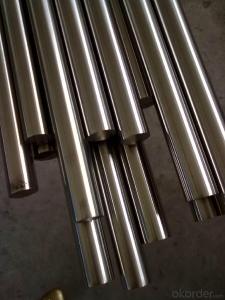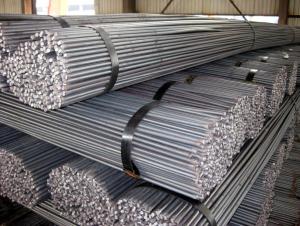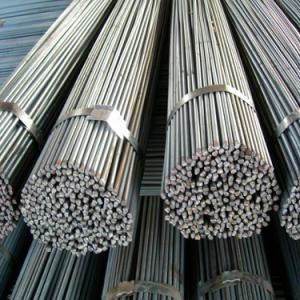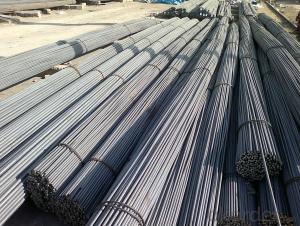Steel Round Bar SS400/S20C/SAE1020/S235JR/S275JR
- Loading Port:
- Tianjin
- Payment Terms:
- TT OR LC
- Min Order Qty:
- 25 m.t.
- Supply Capability:
- 25000 m.t./month
OKorder Service Pledge
Quality Product, Order Online Tracking, Timely Delivery
OKorder Financial Service
Credit Rating, Credit Services, Credit Purchasing
You Might Also Like
Hot Rolled Steel Round Bar
| Standard | Grade | C% | Mn% | Si% | P% | S% | Cr% | Ni% | Cu% | ||
| JIS G3103 | SS330 | <0.050 | <0.050 | <0.20 | |||||||
| SS400 | <0.050 | <0.050 | <0.20 | ||||||||
| SS490 | <0.050 | <0.050 | <0.20 | ||||||||
| JIS G4051-2005 | S15C | 0.13-0.18 | 0.30-0.60 | 0.15-0.35 | <0.030 | <0.035 | <0.20 | ||||
| S20C | 0.18-0.23 | 0.30-0.60 | 0.15-0.35 | <0.030 | <0.035 | <0.20 | <0.20 | <0.20 | |||
| ASTM A36 | ASTMA36 | <0.22 | 0.50-0.90 | <0.40 | <0.040 | <0.050 | <0.20 | <0.20 | <0.20 | ||
| ASTM A568 | SAE1015 | 0.13-0.18 | 0.30-0.60 | <0.040 | <0.050 | <0.20 | <0.20 | <0.30 | |||
| SAE1017 | 0.15-0.20 | 0.30-0.60 | <0.040 | <0.050 | <0.20 | <0.20 | <0.30 | ||||
| SAE1018 | 0.15-0.20 | 0.60-0.90 | <0.040 | <0.050 | <0.20 | <0.20 | <0.30 | ||||
| SAE1020 | 0.15-0.20 | 0.30-0.60 | <0.040 | <0.050 | <0.20 | <0.20 | <0.30 | ||||
| EN10025 | S235JR | 0.15-0.20 | <1.40 | <0.035 | <0.035 | <0.20 | |||||
| S275JR | <0.22 | <1.40 | <0.035 | <0.035 | <0.20 |
Packaging & Shipping
In Bundles with strong lines. Accordig to our experience, It's export package which can keep round bar steady.
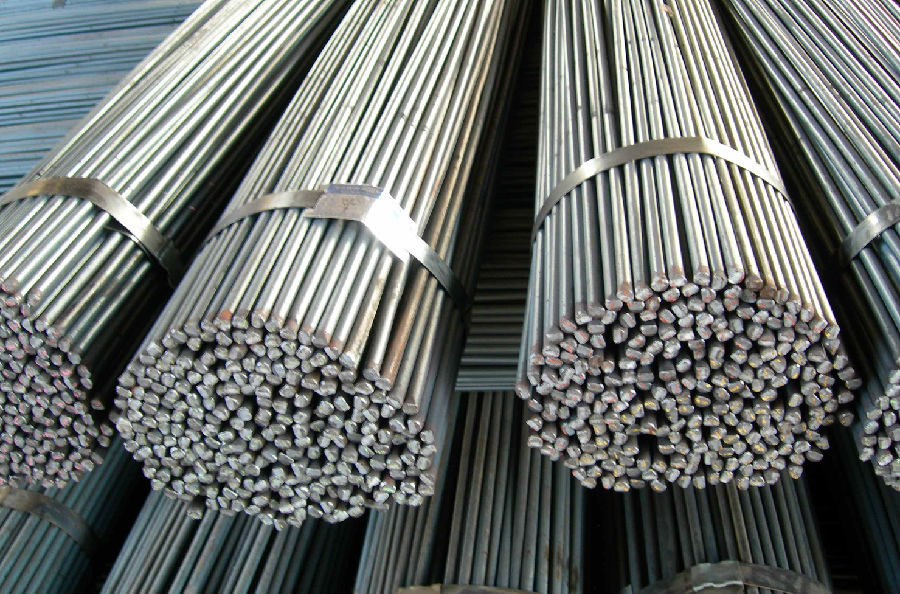
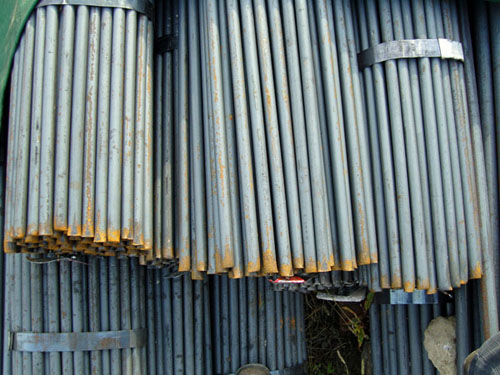

- Q: Are steel round bars available in different colors?
- No, steel round bars are typically available in a silver or gray color as they are made from alloyed iron and carbon.
- Q: What is the impact strength of a steel round bar?
- The impact strength of a steel round bar refers to its ability to withstand sudden forces or shocks without breaking or fracturing. It is a measure of the material's toughness and resistance to impact loads. The impact strength of a steel round bar is influenced by various factors such as the composition of the steel, its heat treatment, and any additional alloying elements. The impact strength is typically determined through testing, such as the Charpy or Izod impact test, which involves striking a notched sample of the steel bar with a pendulum and measuring the amount of energy absorbed by the material before it fractures. The results are usually reported in terms of the energy absorbed in joules (J) or foot-pounds (ft-lb). The impact strength of a steel round bar can vary greatly depending on its grade or specification. Different grades of steel have different levels of toughness, with some being more suitable for applications requiring high impact resistance, such as construction, automotive, or heavy machinery, while others may be better suited for less demanding applications. It is important to note that the impact strength is just one of the many mechanical properties that need to be considered when selecting a steel round bar for a specific application. Other factors, such as tensile strength, yield strength, hardness, and corrosion resistance, should also be taken into account to ensure the optimal performance and durability of the steel round bar in its intended use.
- Q: What are the advantages of using niobium-alloy steel round bars?
- Niobium-alloy steel round bars offer numerous benefits. Firstly, they possess exceptional strength and toughness. By incorporating niobium, the steel's strength increases while maintaining its ductility, making it ideal for applications requiring durability and high strength. Consequently, these round bars can withstand heavy loads and shocks without deforming or breaking easily. Secondly, niobium-alloy steel exhibits high resistance to corrosion. Consequently, it proves suitable for use in harsh environments where exposure to moisture, chemicals, or corrosive substances is common. The corrosion resistance ensures that the round bars remain intact and retain their structural integrity over time, reducing the need for frequent replacements and maintenance. Moreover, niobium-alloy steel demonstrates excellent weldability and formability. It can be effortlessly welded and fabricated into various shapes and sizes, making it adaptable to different manufacturing processes and applications. This adaptability enables the production of custom-designed round bars that meet specific project requirements. Additionally, niobium-alloy steel possesses superior heat resistance properties. It can endure high temperatures without losing strength or experiencing significant changes in its mechanical properties. Thus, it proves suitable for applications involving exposure to extreme heat or thermal cycling, such as in the aerospace or automotive industries. Furthermore, niobium-alloy steel is renowned for its exceptional fatigue resistance. It possesses a high endurance limit, enabling it to withstand repeated loading and unloading cycles without experiencing fatigue failure. This quality makes niobium-alloy steel round bars ideal for applications involving dynamic or cyclic loading, such as in structural components or machinery. In conclusion, the utilization of niobium-alloy steel round bars grants advantages such as high strength, corrosion resistance, weldability, formability, heat resistance, and fatigue resistance. These properties make niobium-alloy steel a reliable and cost-effective choice for numerous industries and applications.
- Q: What are the typical tolerances for steel round bars?
- The specific requirements of the application or industry can cause variations in the typical tolerances for steel round bars. However, common standard tolerances are generally accepted. Regarding diameter, the tolerances for steel round bars typically fall within a few thousandths of an inch. This means that the actual diameter of the bar may slightly deviate from the specified diameter, but it will still be within an acceptable range. In terms of straightness, steel round bars are commonly manufactured with a tolerance for some deviation from a perfectly straight line. The usual tolerance for straightness is measured in units of inches per foot or millimeters per meter. This means that the bar may have a slight bend or curve, but it should not exceed the specified tolerance. Surface finish is another important factor for steel round bars. The tolerance for surface finish is usually specified in terms of roughness average (Ra) or surface roughness in micrometers. This tolerance ensures that the bar's surface is smooth and free from significant imperfections, such as pits or scratches. It is important to note that these typical tolerances can vary depending on the specific grade or type of steel used, as well as the intended application. Precision or critical applications may require tighter tolerances, while less demanding applications may accept looser tolerances. Therefore, it is recommended to consult relevant industry standards or specifications to determine the specific tolerances required for a particular steel round bar.
- Q: Can steel round bars be threaded?
- Yes, steel round bars can be threaded. Threading is a common process used to create a helical ridge on the surface of a round bar, allowing it to be securely fastened to other components or fittings.
- Q: What are the options for joining steel round bars?
- Joining steel round bars can be achieved through various methods, depending on specific requirements and applications. Some commonly used techniques include welding, bolting, adhesives, mechanical couplings, and cold forming. 1. Welding is a widely employed method to join steel round bars. It entails melting the ends of the bars and fusing them together using arc welding, MIG welding, or TIG welding. This technique ensures a robust and durable joint capable of withstanding high loads and stresses. 2. Bolting involves using bolts, nuts, and washers to connect steel round bars. Holes are drilled through the bars, and bolts are inserted, securing them together by tightening the nuts. Bolting is a relatively simple and swift method that allows for disassembly and reassembly, if necessary. 3. Adhesives can also be utilized for joining steel round bars. Industrial-strength adhesives are applied to the mating surfaces of the bars, which are then pressed together and left to cure. This bonding technique can provide a sturdy and durable joint, particularly when welding or bolting may not be feasible or desired. 4. Mechanical couplings, specifically designed for joining steel round bars, are comprised of two separate components fitted over the ends of the bars. These components are tightened together using screws, clamps, or other mechanical means, ensuring a reliable and secure joint without the need for welding or drilling. 5. Cold forming techniques, such as swaging or crimping, can also be employed to join steel round bars in certain cases. These methods involve mechanically deforming the ends of the bars to create a tight and secure joint. Cold forming is often utilized in applications where welding or other traditional methods are unsuitable. When selecting the appropriate method for joining steel round bars, it is crucial to consider specific requirements, load-bearing capacities, and environmental conditions. Consulting with a professional engineer or welder can help determine the best option based on the specific application and desired outcome.
- Q: What are the advantages of using boron-alloy steel round bars?
- Using boron-alloy steel round bars in various applications offers several advantages. Firstly, compared to traditional carbon steel, boron-alloy steel has significantly higher strength. This increased strength enables the construction of lightweight and durable structures, reducing material costs and improving overall efficiency. Additionally, boron-alloy steel round bars exhibit excellent hardenability. This means they can be heat-treated to achieve desired properties such as increased hardness and wear resistance. This makes them ideal for demanding applications in industries like automotive and construction, where high strength and durability are necessary. Another advantage of boron-alloy steel round bars is their enhanced weldability. They can be easily welded without sacrificing their mechanical properties, allowing for seamless integration into various fabrication processes. This saves time and effort during assembly and ensures the structural integrity of the final product. Furthermore, boron-alloy steel round bars offer excellent resistance to abrasion and corrosion. This makes them suitable for use in harsh environments or applications where exposure to chemicals or moisture is common. The extended lifespan of the material reduces the need for frequent repairs or replacements, resulting in cost savings and improved productivity. Lastly, boron-alloy steel round bars are readily available and cost-effective compared to other high-strength steel alternatives. Their wide availability makes them a viable option for a range of applications, from manufacturing machinery to constructing infrastructure. In summary, the benefits of using boron-alloy steel round bars include higher strength and durability, improved hardenability, enhanced weldability, resistance to abrasion and corrosion, and cost-effectiveness. These advantages make them an excellent choice for various industries that require lightweight, strong, and long-lasting materials.
- Q: What are the different types of steel round bar surface finishes for corrosion resistance?
- There are several types of steel round bar surface finishes that provide corrosion resistance. Some common options include polished, brushed, satin, and electropolished finishes. Additionally, coatings such as galvanized, black oxide, and powder coating can also be applied to steel round bars to enhance their corrosion resistance.
- Q: How do I determine the strength and hardness of a steel round bar?
- In order to assess the strength and hardness of a steel round bar, various methods and tests can be employed: 1. Tensile Test: The strength of a steel bar is commonly determined through this method. It involves subjecting the bar to a tensile force until it fractures, and measuring the maximum force or load it can endure. This test provides information on the bar's ultimate tensile strength, yield strength, and elongation. 2. Hardness Test: Several techniques, such as the Rockwell, Brinell, and Vickers hardness tests, can be utilized to measure the hardness of a steel bar. These tests entail indenting the bar's surface using a standardized indenter and gauging the resulting indentation size. The obtained hardness value indicates the bar's resistance to deformation and wear. 3. Charpy Impact Test: This test gauges the toughness of a steel bar by striking it with a swinging pendulum and measuring the energy absorbed during fracture. It helps assess the bar's ability to withstand brittle fracture under conditions of impact loading. 4. Microstructural Analysis: Examining the microstructure of the steel bar through microscopic observation can offer insights into its mechanical properties. By preparing a polished and etched sample and inspecting it under a microscope, the presence of different phases, grain size, and any structural irregularities can be observed. Various microstructural features can impact the bar's strength and hardness. 5. Chemical Composition Analysis: The chemical composition of the steel bar, particularly the carbon content, significantly influences its strength and hardness. Analyzing the composition using techniques like spectroscopy or chemical analysis can provide valuable information about the bar's mechanical properties. It should be emphasized that these tests and techniques must be carried out by qualified professionals in a controlled laboratory setting to ensure accurate and reliable results. Moreover, specific standards and specifications may exist for different applications, so referring to relevant standards and guidelines can offer further guidance on determining the strength and hardness of a steel round bar.
- Q: What are the different types of steel round bar alloys for improved corrosion resistance?
- There are several types of steel round bar alloys that are known for their improved corrosion resistance. Some of the commonly used alloys include stainless steel, weathering steel, and duplex stainless steel. 1. Stainless Steel: This alloy contains a minimum of 10.5% chromium, which forms a thin, protective layer of chromium oxide on the surface of the steel. This layer acts as a barrier against corrosion, making stainless steel highly resistant to rust and other forms of corrosion. Different grades of stainless steel, such as 304 and 316, offer varying levels of corrosion resistance depending on the specific application. 2. Weathering Steel: Also known as Corten steel, weathering steel develops a protective rust-like appearance when exposed to the weather. This self-healing characteristic makes it resistant to atmospheric corrosion. The addition of copper, chromium, and nickel in weathering steel enhances its corrosion resistance and enables it to withstand harsh environmental conditions without the need for painting. 3. Duplex Stainless Steel: Duplex stainless steel is a combination of austenitic and ferritic stainless steels. This alloy offers excellent corrosion resistance due to its high chromium and molybdenum content. Duplex stainless steel is particularly resistant to localized corrosion, such as pitting and crevice corrosion, making it suitable for applications in aggressive environments like marine and chemical industries. It is important to note that the choice of steel round bar alloy for improved corrosion resistance depends on the specific application requirements and environmental conditions. Consulting with a materials engineer or corrosion specialist can help determine the most suitable alloy for a particular application.
Send your message to us
Steel Round Bar SS400/S20C/SAE1020/S235JR/S275JR
- Loading Port:
- Tianjin
- Payment Terms:
- TT OR LC
- Min Order Qty:
- 25 m.t.
- Supply Capability:
- 25000 m.t./month
OKorder Service Pledge
Quality Product, Order Online Tracking, Timely Delivery
OKorder Financial Service
Credit Rating, Credit Services, Credit Purchasing
Similar products
Hot products
Hot Searches
Related keywords



